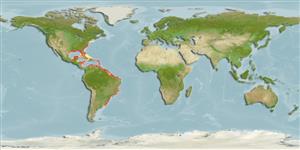>
Carangiformes (Jacks) >
Carangidae (Jacks and pompanos) > Trachinotinae
Etymology: Trachinotus: Greek, trachys, -eia, -ys = rough + Greek,noton = back (Ref. 45335).
More on author: Linnaeus.
Environment: milieu / climate zone / depth range / distribution range
Ecologie
marien; brak water benthopelagisch; oceanodroom (Ref. 51243); diepte 1 - 70 m (Ref. 9626). Subtropical; 43°N - 38°S, 97°W - 35°W (Ref. 44847)
Western Atlantic: Massachusetts, USA through the Gulf of Mexico and scattered localities in the West Indies (Ref. 26938) to Brazil. Also found in Argentina (Ref. 44847). Absent from clear waters of Bahamas and similar islands (Ref. 7251).
Lengte bij maturiteit / Grootte / Gewicht / Leeftijd
Maturity: Lm ?, range 25 - ? cm
Max length : 64.0 cm TL mannelijk / geslacht onbekend; (Ref. 7251); common length : 40.0 cm TL mannelijk / geslacht onbekend; (Ref. 5217); max. gepubliceerd gewicht: 3.8 kg (Ref. 40637); max. gerapporteerde leeftijd: 7 Jaren (Ref. 125592)
Adults occur in coastal waters, commonly entering bays and estuaries. Juveniles found in sandy beaches exposed to wave action (Ref. 5217). Adults are absent from insular areas with coralline habitats (Ref. 5217). They generally form small to large schools. They feed on mollusks, crustaceans and other invertebrates and small fish. Excellent food fish (Ref. 9626). Highest priced marine food fish in the USA (Ref. 171). Have been reared in captivity (Ref. 35420).
Robins, C.R. and G.C. Ray, 1986. A field guide to Atlantic coast fishes of North America. Houghton Mifflin Company, Boston, U.S.A. 354 p. (Ref. 7251)
Status op de Rode Lijst van het IUCN (Ref. 130435: Version 2024-1)
Gevaar voor de mens
Harmless
Gebruik door de mens
Visserij: van groot commercieel belang; Aquacultuur: commercieel; sportvis: ja; Aquarium: Publieke aquaria
Tools
Speciale rapporten
Download XML
Internetbronnen
Estimates based on models
Preferred temperature (Ref.
123201): 23.3 - 28, mean 25.6 °C (based on 454 cells).
Fylogenetische diversiteitsindex (Ref.
82804): PD
50 = 0.5000 [Uniqueness, from 0.5 = low to 2.0 = high].
Bayesian length-weight: a=0.01585 (0.00898 - 0.02799), b=2.82 (2.67 - 2.97), in cm total length, based on LWR estimates for this species & Genus-body shape (Ref.
93245).
Trofisch niveau (Ref.
69278): 3.5 ±0.6 se; based on diet studies.
Weerstandsvermogen (Ref.
120179): Gemiddeld, minimale populatieverdubbelingstijd 1,4-4,4 jaar (Assuming tm=2-4).
Fishing Vulnerability (Ref.
59153): Low to moderate vulnerability (27 of 100).
Climate Vulnerability (Ref.
125649): High to very high vulnerability (69 of 100).
Nutrients (Ref.
124155): Calcium = 57.7 [29.8, 115.8] mg/100g; Iron = 0.97 [0.54, 2.04] mg/100g; Protein = 18.8 [16.7, 20.8] %; Omega3 = 0.281 [0.153, 0.553] g/100g; Selenium = 30.8 [15.2, 64.5] μg/100g; VitaminA = 7.89 [2.08, 26.10] μg/100g; Zinc = 0.721 [0.478, 1.101] mg/100g (wet weight);
